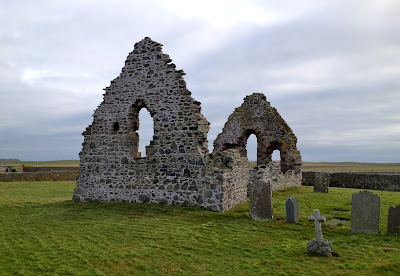With the early morning sun attempting to squeeze its way through the gloom, we disembarked the ferry in Aberdeen and hiked it over the River Dee and into Torry to pick up the car. With over 430 miles to travel before we were back home you would have thought our urge to head south would have been stronger than that of a flock of Swallows in October. Like four confused vagrants though, we put the theory of reverse migration into practice but travelling north instead.
 |
| St Mary's Chapel at Rattray dates from the late 12th Century. Photo by Adam Archer |
Just under a hour later we arrived at Rattray Head. After parking near the spookiest looking B&B in Britain we cautiously picked our way through the dunes and down towards the beach. Within seconds, Jules did exceptionally well in picking up our target bird around the high tideline, a long staying female DESERT WHEATEAR. This hardy little creature had remained loyal to this exposed, sandy landscape since it was initially found on the 2nd December 2012. Whilst studying the bird it was hard not to feel a wee bit sorry for it considering it should have been hopping around on much warmer wintering grounds than these. Depending whether its origins lie in Central Asia or North Africa it should have been enjoying this part of the year in north-west India or around the Sahara or Sahel regions from Mauritania to Ethiopia. It just goes to show how resilient some species of bird are.
 |
| DESERT WHEATEAR (female) Rattray Head, Aberdeenshire. Photo by Dave Perrett |
 |
| DESERT WHEATEAR (female) - Rattray Head, Aberdeenshire. Photo by Dave Perrett |
Other species in the area included 8 Great Northern Diver and 2 Red-throated Diver offshore as well as 2 Long-tailed Duck, 55 Common Eider, 6 European Goldeneye, 6 Red-breasted Merganser and the odd Northern Gannet. Around the beach there were 30 European Shag, 20 Northern Lapwing, 5 European Golden Plover, 14 Oystercatcher, 33 Eurasian Curlew, 18 Dunlin and 32 Herring Gull. On the way back through the dunes my first European Stonechat of the year was also logged, a handsome male.
 |
| Paul Hackett trying out his new digiscoping kit. Rattray Head Lighthouse was built in 1895. Photo by Adam Archer |
We then negotiated the rough track back towards the south end of the RSPB Loch of Strathbeg reserve, chancing upon a singing male Corn Bunting as we did so. Up to 80,000 Pink-footed Geese winter in this corner of Aberdeenshire and I made a rough estimate that around 5,000 of these were feeding in the surrounding fields as we drove through. Scanning from the ruins of St Mary's Chapel I also picked out 11 Barnacle Geese, a single Common Buzzard and 33 Eurasian Curlew. Out on the loch there were 3 Mute Swan, 4 Whooper Swan, 52 Mallard, 4 Gadwall, 14 Eurasian Teal, 22 Eurasian Wigeon, 6 Shoveler, 16 Tufted Duck, 45 Common Pochard, 30 European Goldeneye and 2 Eurasian Coot. There were also 20 Common Gull, 4 Black-headed Gull and 2 Skylark in the area.
 |
| Phil, Steve & Jules prepare for the long ride home. Check out the ASBO Birderz signage! Photo by Adam Archer |
Finally it was time to head home. After nearly 500 miles and just over eight hours worth of travelling I finally arrived home at around 7.40pm. After a long soak in a hot bath and a delicious plate of homemade karahi gosht prepared by Nadia it was time to hit the sack. Another epic twitch had come to an end....... but for how long?

No comments:
Post a Comment